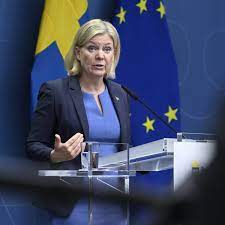Europe and the rise of the far right

Brussels: Cooperation between the right and the far right is advancing apace in Europe. In October last year, an executive made up of conservative parties took office in Sweden with the external support of a far right party. In Italy, another government of the far right with Giorgia Meloni at the helm was elected with conservatives sitting in the executive. In June, a coalition government was also formed in Finland that includes extreme right-wingers in ministerial posts. Polls point to a coalition of the popular right and far right as a likely coalition in the next Spanish government, and it is already a reality in several of the country’s autonomous regions. The leader of the Spanish Popular Party said in an interview with the newspaper El Mundo that “it would be good for the EU if Meloni ended up in the EPP” (European People’s Party).
On the other hand, the far right retained its mandate in Hungary in April 2022, and has the prospect of winning another mandate in Poland in elections scheduled for later this year. It is also on the rise in Germany and has almost annihilated the supposedly moderate right in France.
The rise of the far right and its influence on the traditional right — whether in coalition or not — represents the most momentous political story of our time in Europe. There has been abundant warning of the risks involved. What has really happened in recent months? In Spain, this Saturday was a day of reflection ahead of the vote, and so it was a good time to review some significant signals coming from the rest of Europe about how conservative parties are evolving in this context. Of course, there are differences between the various far-right parties, and there are differences in how the traditional conservative and similar parties react, but it is clear that there are also common trends.
The huge, forbidding, prison-like barge that docked this week in the U.K. is a reminder that immediate reliance on far-right groups is not necessary for their influence to make its mark on traditional conservative parties. The British Conservative Party was radicalized years ago under strong pressure from UKIP, which induced them to call the Brexit referendum and inadvertently opened the English nationalist floodgates, which is something many voters now regret. After the disappearance of their main rival, they are still a party that defends such ideas as processing asylum seekers in Rwanda — a decision considered illegal by a British court (and, one must remember, similar to one put forward by the social democrats in Denmark). The Tory Party has put forward other extreme measures and seems comfortable with a boat that, although it will not lock people up, represents a new, harsher way of doing things. Heavy-handedness in immigration matters is a recurring feature.
In Sweden, the new coalition government has agreed to tighten the country’s traditionally generous asylum conditions. At the same time, it has for the first time in decades dispensed with a specific, autonomous Ministry of the Environment. Matters related to the environment will now be managed under the umbrella of the Ministry of Energy, Industry and Business. This is one of the outward signs of the far right’s growing influence. Another symptom of this phenomenon has been the opposition of the European People’s Party to the EU’s Nature Restoration Law. Disassociating itself from the pro-European majority, the group voted with the far right. It lost, because of the support the law received from other groups and from some MEPs who did not toe the party line. The EPP also opposed legislation on pesticides. An attempt is being made to moderate the green push and to challenge the role of the far right as a rallying point for farmers and ranchers.
In Finland, the far-right head of the Ministry of Economy had to resign a few days after taking office because of the scandal unleashed when his past jokes about Nazism and references such as “Heil Hitler” became known. It served as a reminder of the serious problem that can arise when people who have embarrassing records end up leading democratic institutions.
In Italy, the popular Forza Italia has not taken up political arms against Giorgia Meloni’s decision to limit the parental rights of homosexual couples. Authorities are already acting in the city of Padua to remove the non-biological mother from the registry in about 30 cases of lesbian couples.
In France, although there are signs that it is weakening, the cordon sanitaire remains in place against the far right. However, it is worth noting that several politicians of the supposedly moderate right who were vying for the candidacy in the last presidential elections took up the idea of calling a referendum to establish the primacy of French law over EU law on immigration, a real torpedo to the hull of the European project.
In Germany, the CDU is also maintaining the cordon sanitaire. Again, however, there are striking symptoms. Party leader Friedrich Merz described a speech delivered at a party event by Claudia Pechstein as “brilliant.” A policewoman and former skating champion, Pechstein railed against asylum seekers, non-traditional families and gender-neutral language while dressed in her uniform. The liberal wing of the party was stunned. This week, Merz said something else that attracted a lot of attention: that the CDU “should be an alternative for Germany with substance.” It was not clear from the speech whether it was Alternative with the capital letter of the extreme right party — Alternative für Deutschland — or with a lower case, as in an alternative in the abstract, but the coincidence was so striking that it left many dumbfounded.
These are examples that point to where things are going in the most problematic battlefields: immigration, environment, the past, European integration, civil rights, and values.
Of course, in the European progressive camp, too, there are major failures and serious risks. It is a mistake to underestimate or minimize them. Jean-Luc Mélenchon also proposed, if he won the presidential elections, to break European Union treaties if they hindered his program for government; French socialists, moribund due to the accumulation of errors in previous decades, reached agreements with him in the legislative elections. This is not the only example that can be cited.
However, at the European level, there are growing signs that the risks from the far right are greater in two key areas: the erosion of civil rights and of the common European project. The defense of minorities or disadvantaged groups is a fundamental attribute of democracy, and the pooling of national sovereignty in certain areas is an essential condition for European democracies to prosper in the global arena.
In the European Council, capitals with Europhobic traits (Budapest and Warsaw) or varying degrees of Euroscepticism (Rome, Prague, and Helsinki) are not far from the 35% blocking minority. Conservatives and the far right are not likely to fall far short of a majority in the next European elections. How much will the conservatives in Brussels be swayed by the push from the far right and the coalitions they maintain with them? What about national measures? More ships like those in the U.K.? Fewer rights and protections for the LGBTQI+ community? Less support for women on the road to full equality?
There are national differences. The situations of Hungary and Poland have nothing to do with those of Western European countries. In some, the phenomenon is more disturbing; in others, less so. History, the rootedness of a democratic, egalitarian culture and other factors play a role. But in the overall European picture, there are several corners in which the popular blue is becoming dark, almost black. And it can also end up fading the blue of the European flag.





